Roses for hot & dry, hot & wet, shady & dry, shady & wet locations
Khalid compiled a fantastic rating of roses in his extremely hot climate up to 115 F. I re-post the 3 categories that Khalid wrote:
CATEGORY A - CULTIVARS THAT PERFORMED REASONABLY WELL IN HOT SUMMERS AND MONSOON
Crown Princess Margareta, William Morris, Glamis Castle, The McCartney Rose, Paul Neyron, Rose de Rescht, The Dark Lady, St. Swithun, Alan Titchmarsh, Graham Thomas, Golden Celebration, Iceberg, Burgundy Iceberg, Casino, Ebb Tide, St Ethelburga, Westerland, Blue for You, (please note that most of the roses are DA / OGRs)
CATEGORY B - CULTIVARS THAT PERFORMED BETWEEN REASONABLY WELL AND POOR
The Prince, Chartreuse de Parme, Jubilee Celebration, Pat Austin, Gruss an Teplitz, Lady Emma Hamilton, Tradescant, Princess Alexandra of Kent, Doris Tysterman, Winchester Cathedral, L.D.Braithwiate, Julia Child, Fragrant Cloud, Violette Parfumee, Bronze Star, Shocking Blue, Rhapsody in Blue, Gold Medal, Fredrick Mistral, Mirandy, The Alnwick Rose, Jude the Obscure, Just Joey, Tom Brown, La France, Oklahoma, Black Prince, Scentimental, Belley Epoque, Augusta Luise, Hafiz Zaman, Parveen Shakir, Tipu Sultan, Secret, Liv Tyler, Crimson Glory, Papa Meilland, French Lace, Maurice Utrillo, Fourth of July, Evelyn May, Alexander, Gentle Hermione, Graaf Lennart, (a mix of DA, Hybrid Tea, Floribunda)
CATEGORY C - CULTIVAS THAT EITHER DID NOT BLOOM AFTER SPRING OR PERFORMED POORLY OR BOTH
Gertrude Jekyll, Benjamin Britten, Sharifa Asma, Teasing Georgia, Double Delight, Troika, The Painter, Sheila's Perfume, Mary Rose, Condisa de Sastago, Pink Perfume, Bajazzo, Signature, Maria Shriver, Chippendale, Rouge Royale, Papi Delbard, Alec's Red, Heritage, Charlotte, Spirit of Freedom, Jasmina, Abracadabra, Black Bacara, Fragrant Charm, Deep Secret, Michelangelo, Fragrant Plum, Nahema, Golden Showers ... mostly hybrid teas. Khalid in Islamabad, Pakistan at above 110 F. heat.
**** From Straw: For my Chicagoland heat of above 90, these are the OWN-ROOT roses that thrive in hot & dry ... also mostly David Austins:
For full sun & heat tolerant: Mary Magdalene, Crown Princess Magareta, William Morris, Christopher Marlowe, Radio Times, Evelyn, Lilian Austin, Scepter'd Isle. These have big & deep root that don't need frequent watering.
For the non-Austin roses: Bayes Blueberry (upper rose), and Angel Face (lower rose) in the below pic. Both like it hot & dry, and bloom at over 100 F in August.
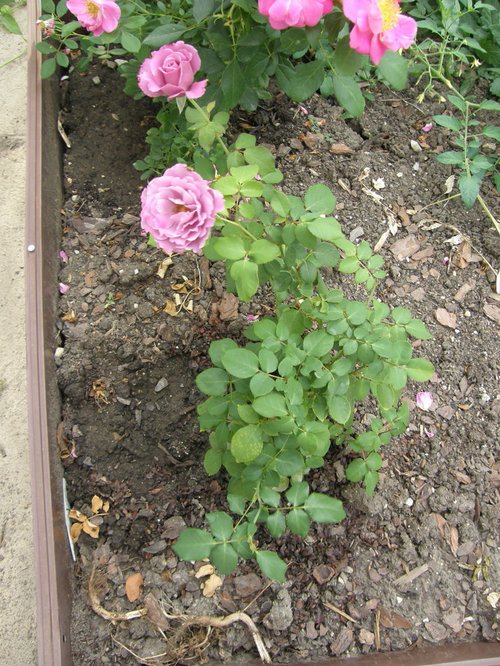
Comments (52)
bluegirl_gw
7 years agoThat's an informative list--very helpful for my hot dry climate--thank you!
It's a shame that many of the teas & Chinas that do so well in the heat might be too tender for your winter, but there are some great polyanthas & HMs listed, too.
The two roses that come to mind that absolutely seem to LOVE the heat here are "Caldwell Pink" (possible wichurana hybrid) & Little White Pet. Both bloom their heads off in the worst heat of the year, in full sun.
strawchicago z5 thanked bluegirl_gwKhalid Waleed (zone 9b)
7 years agoThats a great thread Straw. Thanks for starting.
Bluegirl and Straw: Thanks for naming few more heat tolerant roses. I have noted the names. And I fully agree with bluegirl that OGRs are true survivors. So many of them perform equally well in cold as well hot climate.
best regards
strawchicago z5 thanked Khalid Waleed (zone 9b)Related Discussions
Suggestions for a dry and shady spot...
Q
Comments (33)Interesting discussion going on about Astilbes...I have the Arendsii type, planted about 10 years ago under a pear tree. Over the years it has naturalized all over the garden, it has seeded itself in the full sun, shade, semi-shade, even the cracks between my pavers on the patio! I water my entire garden about once a week during drought periods, but this season has been somewhat rainy, so I haven't watered much at all. So, I guess it depends on which type of Astilbe you plant, because I planted a different type in semi-shade a few years ago, and the thing died the first season!! Go figure! LOL. Every garden is different (soils, climate, sunlight, etc.), which makes gardening somewhat of a challenge to see what will survive and thrive. You just have to try things yourself because you just never know! Plants will surprise you all the time...which is what I find so amazing about gardening....See MoreDry, shady dirt under cedars
Q
Comments (8)Plantmaven's link mentions zexmenia (wedelia texana) as a common "cedar" understory plant. This would also be a good one for covering large areas. Long blooming in sun or shade, low water use, and can be easily propagated by layering. I've seen these growing with yellow-orange flowers, but most around here are closer to yellow. Ours tends to grow flatter in sun where it doesn't get much over 18" tall, but can get 5' wide when left untrimmed - good if trying to cover a lot of ground, but can be a challenge for small spaces; not an aggressive spreader, just a wide plant. It is a taller, more docile grower in shade....See MorePot plants for dry shady verandah.
Q
Comments (4)Have you considered aspidistras (cast iron plant)? I love them and have large pots of them in various situations. They don't seem to mind whether they are in full sun or full shade or anything in between, are extremely hardy to frost and cold (although the leaves tend to get a bit tatty in windy situations), and don't seem to notice if you forget to water them. The leaves, dark green and a bit stripey, have a tropical look to me and an established pot looks lush and rich. They do have flowers but these are insignificant and bloom almost at ground level and will only be found by accident....See MoreHot, hot and dry
Q
Comments (19)Here in No Cal no one is complaining about the heat, even though it has been in the 90s and 100s F, and humidity mostly 15-20%. What folks are complaining about is the smoke & fires. Our "fire season" usually is in Oct, but this year it started in July. Hundreds of thousands of acres burning, dozens of serious fires, just in the Northern half of the state. Firefighters are here from all over the US. We were just at our cabin up in the mountains West of Redding, and there are so many large fires (total acreage is over 150,000 and counting) in just that one remote county (Trinity county) that they have stopped calling them by name, and are calling them by 4 different "complexes". They usually give each fire a name, but the fires have been merging, so no longer using the names. 3,000+ fire fighters, who are just trying to get lines around the fires - do not have the ability to put them out, but trying to keep them away from the little towns. Over 4 dozen houses burned so far. When a successful fire break is 100% all around a fire, they call it "contained". In one of the larger complex of fires, the "estimated containment date" is Oct 1! And that is just in one county. Nearer the SF Bay Area there are numerous small fires, and two big ones which have been burning for 3-4 weeks, and have also burned over 45 houses and 130,000 acres. The smoke travels 100s of miles in the mountains - our cabin is way far away from the big fires, but none the less when we left yesterday, you could hardly see the trees right across the creek from our cabin - I was glad we were going home. The Red Cross has set up "clean air" shelters, in schools and senior centers, etc, with HEPA filters on the buildings, to filter out the smoke. Very scary. Nik, I know this sort of thing has happened in Greece before, so you know what I am talking about - when Mediterranean climates get winter droughts on top of our normal hot & dry summers, the native vegetation (which is drought tolerant because full of natural resins ) just explodes. So, we all are sincerely hoping that we will get an actual winter this year, for the first time in 3 years. Of course, that will cause floods and mud slides on the denuded hills, but the fires will go out. Jackie...See Morebluegirl_gw
7 years agoCaldwell Pink
Little White Pet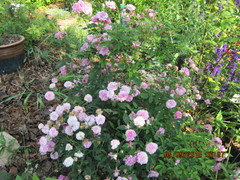 These are both in full day sun. I think they are part lizard, they both love hot sun so much :-D
These are both in full day sun. I think they are part lizard, they both love hot sun so much :-D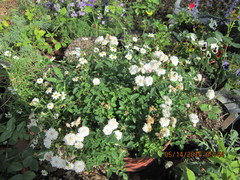 strawchicago z5 thanked bluegirl_gw
strawchicago z5 thanked bluegirl_gwstrawchicago z5
Original Author7 years agolast modified: 7 years agoBluegirl: That's funny .. yes lizards like hot sun. Your Caldwell Pink is awesome, so many blooms .. same with White Pet !! That blue Salvia at the corner goes well pink blooms.
I pulled Perle d' Or rootings out of the pot .. IT DIDN'T ROOT in the fluffy 1/2 perlite & 1/2 pine fines, but Darlow's Enigma rooted well in that fluffy soil with at least 3" long roots. Hybrid musk is known to like dry & shady & loamy soil.
Does Perle d' Or like clay? Interesting that Perle d' Or is known as "yellow Cecile brunner".
Alana8aSC
7 years agoLilian Austin does well in hot and wet. As well as Mme. Lombard, and other OGR if you would like me to name them . We have a dry and hot summer, and I did have to water once when they started looking droopy- but that was only Threse Bugnet and Kazanlik, who was drooping, but I went ahead and gave everyone some water. I actually have a pretty decent amount of OGR that do well with this. I have three kids and do not have alot of time, so I love the true survivors!
strawchicago z5 thanked Alana8aSCbluegirl_gw
7 years agolast modified: 7 years agoYeah, down here some of the old teas are really rugged. I have Mrs. B. R. Cant & Mons. Tillier in the ground, heavily mulched & have only bothered to water them twice these hot dry three months. Sure, didn't get tons of flowers, but I didn't have to baby them through the drought. They'll both put on a splendid show this fall now that we got some rain.
Straw, Sorry about Perle--I'm usually able to root it & will try again this Sept. Congrats on Darlow's though! I suspect Perle does well on clay, or at least tolerates it well. I had it on the coastal prairie & it was a star there, too. This bush & the Cecile are in the ground here. I fill the holes with potting soil now, but the unamended native dirt around it is alkaline, with caliche & some clay like junk, too.
I grow both Cecile & Perle. Both are utterly carefree in hot sun. I don't even have to water them though I do. Both are heavily mulched.
Vintage Gardens' Gregg Lowery's comments are interesting. Both CB & Perle have similar breeding (though somewhat disputed): a polyantha x a tea rose. Mme. Falcot for Perle & Mme. de Tartas for Cecile. He says Cecile was such a breakthrough with its little scrolled tea like flowers that: "it's astonishing it didn't lead to its own great class of roses".
Informally, the tea crosses are known as Poly-Teas or PolyPoms
He continues: " A few others of its breeding were created, including the exquisite Perle D'Or, & lovely seedlings were raised, such as Pasadena Tournament, Red Sweetheart and Lady Anne Kidwell, but this remains a small & very precious group of roses"
I'm a bit partial to Perle D'Or since, for me, I get larger & prettier flowers. They also hold the apricot coloring well, even in full sun, whereas my Cecile tends to fade to raggedy white quite soon. Kim Rupert always emphasizes that Cecile grows in a large range of forms, a continuum, from the compact bush (like I have) to Spray Cecile (I have an old clone of it), to the gigantic climbing Cecile which in some areas puts out one massive spring flush.
The Spray Cecile I have dates back at least 60 years. It has a prettier flower than my bush clone, but can grow enormous. So vigorous that I've been using it as a root stock, with good luck. But it's not as tidy a plant as the bush--quite a thug :-)
Perle D'Or blooms

bush

Spray Cecile
It also has what I called Palmate leaves on the bloom canes, which make candelabras of little flowers. Kim forwarded me some old references to this, where they're correctly called bracts. I think these might even survive your Chicago winters, unlike the teas.
I think these might even survive your Chicago winters, unlike the teas.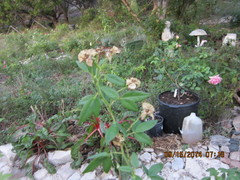 strawchicago z5 thanked bluegirl_gw
strawchicago z5 thanked bluegirl_gwstrawchicago z5
Original Author7 years agolast modified: 7 years agoBluegirl: Thank you for those pics. of a huge & healthy Perle d' Or bush. The history of Cecile Brunner and Perle is very interesting. Is tea generally drought-tolerant?
The Perle rooting died in a pot last winter since the peaty potting soil was too wet ... that was before I drilled at least a dozen holes in my plastic pots.
Your Spray Cecile bloom is very pretty .. I like that pinkish shade. Anything big in your warm Texas climate will be tiny in my cold zone. The white-pet you sent is shorter than my index finger, and the pink-pet was just as tiny, and died when we had 6 inch. of rain in one-day.
I should had planted both up the hill, where it's drier. Soaking wet clay can make minis out of any plant .. Madame Isaac Pereire died to the crown .. nothing but a 4 inch. root .. then I moved that up hill (drier), and it got huge. If I post pics. of my "roses-made-tiny" by soaking wet clay, you'll break out laughing !!
I didn't know that Madame Isaac Pereire is drought-tolerant until I read the comments section in HMF .. it almost died in the "swimming pool" I made by plastic-landscape-edging, dug down to 6 inch. to prevent grass from growing into my wet clay.
bluegirl_gw
7 years agoI need to send you some! Caldwell Pink is pretty much fail-proof here, unless it's in shade.
Little White Pet, as an own-root, took a couple of years to build up nicely from a tiny band. Kept buds pinched off for a long while, now I can let it cover itself with flowers, which it often does. IIRC, it's possibly a dwarf sport of Felicite et Perpetue, thought to be a Sempervirens hybrid x a Noisette. Most Noisettes do well here, too.
The teas & Chinas pretty much do well all over TX, but we're not as hot & droughty as CA or NV. Since you grow off plants so fast, maybe late summer/fall you could take cuttings of anything you wanted to carry over? Maybe you already do--I was just thinking it might be useful to carry over a few small bands of cuttings, just in case. I used to do that with tropicals that got too big over the summer to haul inside--just carry over a few small pots of cuttings during the winter to have replacements if the mother plants got frozen.
Angel Face & Mme. Isaac are so beautiful & fragrant, but neither has done well for me. I did see some gorgeous Angel Faces planted in the rose garden of the town I used to live in, so it can do well there, I just couldn't make it happy.
strawchicago z5 thanked bluegirl_gwstrawchicago z5
Original Author7 years agolast modified: 7 years agoBluegirl: THANK YOU for the suggestion: "it might be useful to carry over a few small bands of cuttings, just in case." I agree, I really should make back-up rootings to be garaged, just in case the mother-plants die through my zone 5a winter.
Remember Kim (Roseseek) technique of "burrito wrapping" with newspaper to induce callous on cuttings? Cuttings need "tight contact" to be calloused.
I received your bundle of Darlow's Enigma's cuttings tied together with a twist tie .. I could not untie that, so I left the cuttings bundled up together and stuck into soil .. that created "tight" contacts among the cuttings, and they rooted very well. In contrast, I SEPARATED the Perle'd Or cuttings, and stuck each one in, and each cutting flopped around in a 1/2 perlite & 1/2 pine-fines medium .. they could not callous, although Darlow and Perle are in the same pot.
Among the 10 own-roots I received from Roses Unlimited 3rd-week-of-June, Strike it Rich was a loser: just skinny stems in the left-most pot below:
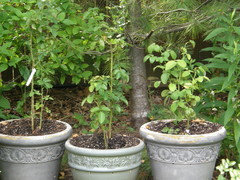
I got fed up with its look (pic. above taken end of June), so I planted into my clay first. It was the 1st one to give 4 blooms for 1st flush. Then it gave 6 buds for 2nd flush, pic. below taken Thursday, August 18:
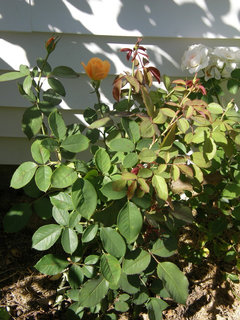
No other roses in the remaining 9 pots can match the performance of Strike-it-rich, the 1st one to be planted into my alkaline clay. The above is 2-months of growth from a wimpy-own-root.
This year my best rooting was achieved with "tight-contact" as in Darlow Enigma's cuttings in a bundle with a twist tie. Also Golden Celebration in a "tight" medium of 1/3 perlite, 1/3 potting soil, and 1/3 clay (pre-broken down with gypsum). This is the 1st time I succeeded in rooting Golden Celebration into band-size, previous years GC refused to root in 1/2 sand and 1/2 potting soil.
CONCLUSION: water-hogs like Golden Celebration need "tight contact" with some clay to root well. Wet & fluffy medium like potting soil isn't best for all roses .. my 9 own-roots in pots are way behind Strike-it-Rich, planted in clay.
Alana8aSC
7 years agoBluegirl the Spray Cecile that I got from you is doing well. I do have her in a pot still but I am fixing to plant her now. she has built up to a good size now. I wonder if I should plant her in afternoon shade to keep the blooms from fading or will they still fade?
I had bad rooting luck this year, I am going to change my median and see if that helps.
bluegirl_gw
7 years agolast modified: 7 years agoAlana, glad to know she's doing well. I think many roses do like afternoon shade, but the Spray Cecile isn't as quick to fade as my bush form is, though it the hottest part of the year, the flowers do lose form & fade quickly. My relatives have that SC all over their yard--in an afternoon-shaded front bed, a full-sun side bed--& it seems to grow fine everywhere. A lady from Louisiana shared it with them as a housewarming gift when they first moved there in the late 50s.. That Spray Cecile has traveled around a lot! It's not as neat & pretty a plant as the tidy little bush form, but if you have room for it, it's an exuberant horse of a plant with very pretty flowers.
Straw, that's funny how the Darlow's did just fine in spite of not being treated in the traditional way! I'm starting to learn to be more flexible with cuttings--some root best in spring, others in summer (Fortuniana), others in Fall. And I need to get off the fixed idea of insisting on trying all cuttings in the same media--my most versatile media is #3 sandblasting sand with a bit of perlite, cuttings rooted in full sun, under mist. But, like Alana, this was an awful year for rooting for me--just rotten!--even things like Chinas & teas rotted on me & usually they're fail-proof.
I'm going to try some of the difficult ones in other medias--you're right, I think cuttings do need to have close contact with the media--whatever it is--to have any chance of success. Perlite may be great for drainage, but it's hard to get close contact with it.
Kim says that at Sequoia & when he worked at the Huntington, he jammed whole fistfulls of cuttings into the tightly packed sand & slammed the pots down hard to tamp them even further to create close contact of the stems with the media, then they went under intermittent mist. The closely packed cuttings humidified each other.
Yes, I read that many folks do very well with the burrito method. I haven't tried it a whole lot, but when I did, although I got lots of callous on the stems, I couldn't get the callous to push into roots. I haven't done it enough, need to practice more.
One of the weird, *wrong way* successes I've seen was this: a lady sent me cuttings (Ragged Robin & Fortuniana) but forgot to mail them Priority. It was in the summer & they took 10 days to arrive. She had wrapped them in damp newspaper & normally, you'd have expected them to be totally rotten upon arrival. But they came calloused! And rooted well, with a high percentage of takes--go figure!
Kim normally does burritos in cool weather--perhaps that's why I can't get them to push roots beyond the callous stage. Some things--like Fortuniana--never root for me without heat. I wish I could set up a more professional system, with bottom heat. I have used a hot bed in fall/winter of rotting hay under the cuttings to help, but I'm rethinking that because of how many times I've had varmints plowing through the cutting bed--I just have to raise them off the ground or enclose the bed much better.
Another neat nontraditional way is how Ralph Moore rooted tons of Pink Clouds cuttings--a vigorous multiflora hybrid that is an excellent root stock. He just poked holes in coffee cans--along the sides, too, IIRC, & stuffed them full of fat stems to be used as stocks & stuck them under the mist!
strawchicago z5 thanked bluegirl_gwstrawchicago z5
Original Author7 years agolast modified: 7 years agoThank you, Bluegirl, for your experience and insights on rootings. Agree that roses are different from each other, thus need different techniques to root. The climber like Dr.Huey & climbing Austins (like Golden Cel.) PREFER clay, so they root best in "tight medium".
French Meilland roses like Yves-rooting HATED the slightly acidic pine-fines medium, and prefer a more alkaline medium. I'm buying neutral-pH-potting soil to mix with sand and alkaline clay for French Meilland's rooting.
I like what you wrote:
" Kim says that at Sequoia & when he worked at the Huntington, he jammed whole fistfulls of cuttings into the tightly packed sand & slammed the pots down hard to tamp them even further to create close contact of the stems with the media, then they went under intermittent mist. The closely packed cuttings humidified each other."
A heating pad does help roots to grow faster. A guy nearby shared with me that he rooted better by WATERING FROM BELOW, via a tray with water. I'm pretty sure that Burlington Roses used the watering from below technique in 2012, that's when she used 1/2 sphagnum moss (the $$$ greenish & airy mossy florist fibers). Her bands were open at bottom (just a criss-cross to hold the soil-mass).
Watering from below prevents molds & damp-off above, plus forcing roots to reach down. One possibility is to put a tray filled with water, on top a heating mat (plugged-in), then put band-size-pots into the tray of water.
bluegirl_gw
7 years agoCool! Thank you for the info! And, of course, their climates are different than ours. Kim was near bone-dry LA when he wrote that, I forget where Sequoia was, but I *think* is was in a slightly moister area, etc. It probably never got really cold there so the burritos worked better, even though they did them in their cool season.
Farther south, though it was technically the same zone I'm in now, I rooted all through winter with hot beds. Often it was superior to spring/fall rooting since the cuttings weren't so heat stressed. Here, I can't reliably root past Oct., though a few things will hang on & root a bit later.
You're dealing with heat, high rain & humidity in the growing season. I have heat & dry air (though not so dry as southern CA).
I do bottom-water rooted cuttings when they're in bands. Lowe's stocks a "boot tray" for storing muddy boots, similar to this, but with even sides. Back where the door mats are, just five bucks & it will hold 30 band pots. It's about 1" tall, so pots don't get swamped but stay moist on the bottom. This is the closest photo I found on a quick web hunt.
strawchicago z5 thanked bluegirl_gwstrawchicago z5
Original Author7 years agoThose boot-trays are so cool !! It makes sense to have a water-tray below, so it evaporates moisture & increases humidity. I should had bought a bag of sphagnum moss (greenish florist fibers) just to test it .. it's very airy and holds oxygen for root-growth, plus it's like a sponge to soak up water from below, plus it provides "tight contact".
Interesting that Connie of Hartwood roses stated that "more rootings died from over-watering than under-watering".
http://hartwoodroses.blogspot.com/2013/05/how-to-root-roses-from-cuttings.html
Burling used sphagnum moss in 2012 and her bands were perfect back then (1/3 sphagnum moss & 1/3 potting soil & 1/3 perlite), then she switched to pine-fines, and it was a big decline in her bands.
Alana8aSC
7 years agoThat's neat Bluegirl about SC. Thanks for sharing! That also great info on rooting and different types. a whole lot of great information :)
Vaporvac Z6-OhioRiverValley
7 years agoFantastic information hear on rootings! I have a book tray just like that....this idea would make good use of it in the summer. A good heating pad might be those used for pet beds outside. When my beloved kitty was old and sick, she couldn't keep her body temp up and loved her heavy duty waterproof pad that I first saw at my vet's. It's very gentle heat so it wouldn't be too hot for the plants. They come in a couple of different sizes. Not as cheap as the boot holder. but they are waterproof. :( https://www.walmart.com/ip/Farm-Innovators-Pet-Heating-Pad-Multiple-Sizes-Available-Dogs-Small-Animals/14660242
I tried deliberately rooting this summer and have had pretty good luck. I originally thought it was just the varieties I tried (Rugosa hybrids), but it may have been the perlite/vermiculite/compost that I used which is very light and similar to its natural growth medium. I followed Hartwood Roses' method. The ones that didn't make it were either kept too long or were past their prime to begin with. I might try my luck with my Orleans polys and Cecile Brunner this Fall. Any thought on what medium might be best for those?
strawchicago z5 thanked Vaporvac Z6-OhioRiverValleybluegirl_gw
7 years agoI need to try sphagnum! Also those heating pads. I definitely lose most cuttings to rot--so too much moisture is something I need to watch. I have some coir ready for the next batch. 1/2 sand, 1/2 coir used to be my favorite medium.
Funny, though: I used to have a rose pal no more than 90 miles away--same climate--& all the roses she shared were rooted with the baggie method with barely moist potting soil. I never got the hang of that--never could root them at all until using sand & mist. But it's probably the most widely successful method for many folks.
Vaporvac: I personally have more trouble with Spay Cecile once temps get cooler. It roots fast & readily in my usual method of sand, full sun & mist, during the growing season, but it took me a couple of tries to root it. I'd collect it Thanksgiving when we visited & then couldn't get the cuttings to root over the cool months. Just my two cents--might add some warmth if your temps cool off too soon.
Most polys I've tried are pretty reliable rooters, though--put out roots within 3 weeks & grow off fast. Had Clotilde Soupert put out 2" roots one June in 15 days--my all-time record :-D May/June's usually a good time--lots of sun & warmth & the plants are actively growing to provide good cuttings. Sept/Oct are good, too. Still warm & sunny.
strawchicago z5 thanked bluegirl_gwAlana8aSC
7 years agoI finally got me some rose seeds growing. One was growing in the bag in the fridge. So excited about this!
strawchicago z5 thanked Alana8aSCbluegirl_gw
7 years agoCongratulations! I don't have a lot of luck with them, but did get some Maid Marion & Orangeade sprouted. MM just bloomed, at 1" tall--so cute!
strawchicago z5 thanked bluegirl_gwstrawchicago z5
Original Author7 years agolast modified: 7 years agoI'm very grateful to Connie of Hartwood who shared how to root roses. Her post in 2011 originally stated 1/2 sphagnum moss to 1/2 perlite. Then she changed that to potting soil later. Sphagnum moss (green florist strands) is easily confused with peat moss (cheap brown dusty-fiber from Canada).
Sphagnum moss is really expensive, $6 for a tiny bag. For $6 I can get a HUGE bag of perlite, many times more. The advantage of $$ sphagnum moss: it's spongy & airy & provide oxygen for roots, and can be watered from below via a tray of water sitting on a heating mat.
There are 2 stages to rooting: The first stage is forming a callous ... that's when the end swells up and becomes whitish. To induce callous, a tight-fitting medium is needed, such as Roseseek (Kim Rupert)'s Buritto method (wrapping cuttings tight in moist newspaper). I induce callous by a tight-fitting & moist medium of clay, sand, and potting soil.
After callous was formed, Kim transferred to MG-moisture control potting soil for his dry & less rain climate. But for my rainy climate, I transfer from a tight-medium to a fast-draining & airy medium of perlite and pine-fines.
The second stage is when tiny roots sprout from the callous, any excess moisture in this stage will result in rot. Thus transferring from a tight-fiting & moist medium to a fast-draining & airy with oxygen makes sense.
When Burling moved away from $$$ sphagnum moss, she induced callous via a tight medium of peatmoss, then transfer that to a looser & fast-draining medium of pine-fines & perlite later. She's in CA with alkaline water, thus using acidic peatmoss to induce callous, and later on, acidic pine-fines make sense.
Last year I rooted in the ground with 1/2 gumbo-clay plus gypsum to loosen the clay and 1/2 coarse sand. Rootings form callous easily, and sprouted new leaves. Then we got tons of rain which rotted the tiny roots.
What I should had done? I should had transferred them to fast-draining, airy medium of 1/2 perlite and 1/2 potting soil, plus dozens of holes drilled all over the pots for fast-draining in my heavy rain.
CONLUSION: for stage 1 of rooting to form callous, a tight & moist medium is needed, such as burrito-method, or dense & moist sand with clay, or a bunch of rootings tied together, stuck into a tight & dense medium.
For stage 2 of tiny-roots coming: a loose & airy & fast-draining medium is needed to prevent rot, such as 1/2 perlite and 1/2 pine fines or potting soil, in fast draining pots that's mostly opened at the bottom. Sand isn't best in this stage, it's too dense for root-growth.
rosecanadian
7 years agoInteresting. I've had only one success in rooting roses...and I don't even remember how I did it. This year, I've tried 3 times to root about 7 cuttings. Hopefully this time will work. I have them in seed starting soil, horticultural sand (probably not the right kind of sand??), coir and some water that clay had been soaking in. They're outside in half sun/half shade. And I've been misting them about 4 times/day. So IF they ever get roots, I should transfer them to a faster draining medium. That's good to know.
Carol
strawchicago z5 thanked rosecanadianstrawchicago z5
Original Author7 years agolast modified: 7 years agoCarol: Thank you for sharing your experience !! Horticultural is the best choice, it's "lime-free washed sharp sand." Menards sells coarse sand for $2 per 40 lb. bag, but it's not wash, has lime, and turned my Munstead Wood into pale & orange leaves (sulfur-deficiency from high pH lime).
HomeDepot sells coarse sand, or paver's sand, more expensive at $3.49, but it has less lime, thus less chlorosis when I mixed into my alkaline clay.
Play sand is decent for rooting, since it's finer & more gentle on roots. Linda of LongAgoRoses recommended playsand for Tammy in TN in her rootings. However, coarse sand is best to fix my rock-hard clay.
For roses that like it dry & hot, fast-draining medium is actually 3/4 perlite and 1/4 potting soil. For 3 years I tried to root Yves-B cuttings in 1/2 perlite and 1/2 potting soil, but failed.
Yves-B was bred by Robert Rippletoe in his hot & sandy California garden. Then my neighbor successfully rooted that in his greenhouse, and when he gave me these band-size-roses, the soil was actually 2/3 perlite and 1/3 potting soil, very fast draining.
rosecanadian
7 years agoI'm surprised...I had horticultural sand (never used it), and thought this isn't what Straw meant for sand..but it's all I have. So I used the right sand. Amazing! :)
So if I actually root these roses...I'll transfer them to perlite/potting soil like you recommend. Unfortunately I didn't have any clear cups...so I used solo cups that one can't see through. But, I guess I could slice the cups vertically and check...then duct tape them back if they're not ready. How long do you think I should wait to look? I guess that probably depends on the weather, etc.
Carol
strawchicago z5 thanked rosecanadianstrawchicago z5
Original Author7 years agolast modified: 7 years agoCarol: I used small cups for rooting one time and gave up. I prefer big pots since it's only one-time transfer, and I can winterize big pots in my garage, but cups will freeze in my unheated zone 5a garage.
Your sand and coir provides "tight and moist medium" to form callous. Coir has potassium, phosphorus, some magnesium to enable rooting. I got a block of dry coir, but haven't tried yet .. will have to rinse that coir repeatedly to get the salt out.
My experience in inducing callous: Stick a bunch of cuttings (tied together for one variety) in a tight & moist medium, my best luck was 1/3 clay (for magnesium), 1/3 sand, 1/3 pine fines or potting soil. Magnesium is very vital for seeds to sprout, and for rootings. It's a nightmare of seeds sprouting in my high-magnesium clay, I get tomatoes sprouting from last year's seeds, birch plants, cherry plants, baby maple trees, you name it sprouting all over.
Sand retains water very well. When the leaves became yellowish (means water-logged), it's time to transfer to a dry & fast-draining medium. Takes 2 to 3 weeks to form callous & need to transfer out.
- I use a big insulated pot for my zone 5a, and I drilled at least a dozen holes for my heavy-rain climate: MORE than 1/2 perlite, less than 1/2 potting soil .. I prefer pine-based potting soil, since it's drier than peat-based potting soil.
When I used 100% pine-fines potting soil, it's zero rot. But the peat-based is what cause rot: too dense & too wet. When new leaves come out that means roots are forming. Takes 2 months to form solid roots.
Recent years it's impossible to find 100% pine-fines potting soil, but easy to buy $6 bag of sphagnum moss, that stuff is ideal for rooting: slightly acidic, dry, fluffy, gives oxygen, and can be watered from below. That's what Connie originally recommended: 1/2 perlite and 1/2 sphagnum moss.
In my and Khalid's observations, hybrid-teas demand more water than Austins and Old Garden roses. A friend gave me a cutting of Oklahoma. I stuck in a cup of rain water, left it outside for 2 weeks, and found lots of roots in that cup of water: no tight contact was needed !! I gave that away, and I realize that hybrid-tea PREFER a slightly acidic medium, such as rain-water at pH 5.6 to form roots.
Thus anything alkaline like un-washed sand (high lime), or alkaline tap water at pH over 8 will make it hard for hybrid tea to sprout roots. That's why hybrid tea are best grafted on an aggressive rootstock that can secrete acid, such as Dr. Huey.
bluegirl_gw
7 years agoThat's interesting! HTs are among the most difficult for me to root successfully. I have better luck budding them, but sometimes don't have stocks ready when I get cuttings. I'll work on using a more acidic media & perhaps watering with a bit of gypsum in the water maybe? I actually don't normally water cuttings once they're struck unless they're taking 6 weeks or more.
The time varies so much. I generally expect decent roots in a month to 6 weeks during warm weather. Varieties that root readily, like Chinas can strike in 3 weeks. Extremely variable. That's amazing you got roots on a HT in water! I've never been able to water sprout any roses.
I have a sack of coir ready. It's from a brick that advertised it is low-salt. Already got it uncompressed & redried. We'll see. May splurge for a sack of the fibrous sphagnum, try that, too.
The sand I've been using is #3 sandblasting sand--very coarse. Although the clear cups may not be the best container, I like them since I can see the roots fast. And as soon as I see roots, I put them into potting soil & start moving them away from the mist.
Another friend sticks cuttings in rock wool cubes, then pots them up as roots come out. I've fooled with them a bit, but not much.
Anytime I use some sort of humidity dome I get rot--dunno why--that & the baggie method are what most of my friends use, but I don't get good results. Perhaps the potting soil has been too peaty. Hmm, I still have a sack of pine fines--maybe I'll let that decay into a media for cuttings of HTs for the next cutting season.
Guess the key is being flexible & sharing results. Thank you all for the neat ideas :-D
#3 sandblasting sand with a bit of perlite. It's very coarse--almost like aquarium gravel. I also *might* try a few stems with perlite in the bottom of the cup but with the cutting stem in a mix of sand/coir. What the heck--it's fun to experiment.
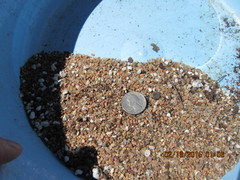 strawchicago z5 thanked bluegirl_gw
strawchicago z5 thanked bluegirl_gwstrawchicago z5
Original Author7 years agolast modified: 7 years agoBluegirl: Thank you for that pic. of #3 sandblasting sand .. I wish I had ordered a load of that when we got our load of gumbo-clay. Roses are different from each other, it's fun to try many methods.
I'll buy a bag of play-sand from Walmart and test its pH. Some rootings have such thin, almost hair-like root .. my hunch is the wimpy-ones prefer a finer-medium. If the play-sand comes out alkaline in pH, it would neutralize the acidity of pine-fines. Surprising Linda of LongAgoRoses' method of rooting was with play-sand, rather than coarse-sand.
Pine fines has tannin, which prevents root-rot. I rooted in pine-fines potting soil before .. had to water it daily, it dried out so fast, but zero rot. The only disadvantage of pine-fines is very little nutrients, the roots became hair-like, rather thick & chubby as in gypsum plus NPK 2-7-4 organic fertilizer.
I check on rock-wool: "It's a fibrous mix of rock and sand. Rockwool is lauded primarily for its retention of water and air ... rockwool holds 18 percent air at all times. That means it's more difficult to overwater the plant, due to the oxygen that encompasses the roots. Rockwool also has naturally high pH levels."
http://homeguides.sfgate.com/rockwool-vs-soil-28360.html
Still remember 2012 experience with Burling's 12 bands of chopped sphagnum moss & perlite & potting soil. I left them in full sun, they dried out in a few hours, so I watered them, then our strong wind blew and spill the stuff out of the bands: when I picked up sphagnum moss, it's dry & airy & light. I'm convinced such medium must sit in a tray of water (watering from below), or constant misting.
There's an old-thread in Rose forum where 2 sides exchanged different experiences in rooting: First group said zero-fertilizer & sterile potting soil is best. The 2nd group said compost, organic fertilizer helped with rooting. My kid 6th-grade-science experiment backed up the second group. She tested growing mung-beans from seeds in various mediums: Seedling plugs with coir/peat, sterile seedling soil, same soil but with Garden-Tone NPK 3-4-4, sand/clay, sand only, MG-organic soil with meat & chicken manure as fertilizer.
At the end of 1 month, MG-organic potting soil with meat & chicken manure came out with the most healthy & tallest plants. Sand/clay sprouted first (due to magnesium in clay), but ranked 3nd at the end. The worst results were with coir/peat plugs and sand, due to zero nutrients.
A bit of clay really speed up rooting, thanks to magnesium. For 2 years I tried to root Golden Celebration in many combos: 1/2 potting soil & 1/2 perlite, 1/2 potting soil & 1/2 sand .. none worked, until I tried 1/3 potting soil & 1/3 sand & 1/3 clay and gypsum & plus Tomato Tone NPK 3-4-6 (chicken manure, bone meal, sulfate of potash). This was the most successful rooting in the shortest time, less than 2 months.
My thickest & most solid rooting was achieved with 1/2 potting soil & 1/2 perlite, plus gypsum and Jobe's Organic NPK 2-7-4. The calcium & high phosphorus and potassium really help with thicker roots. But I let the pot sat for weeks with frequent rains to dilute the fertilizer, before I stuck cuttings in.
rosecanadian
7 years agoOkay, sounds like I did a lot of things right. I actually did put some clay in the mix to help bind everything together. I can fertilize the cuttings with worm leachate. I do have gypsum, perlite and sphagnum moss for the potting up one size which is next.
- Should I put the cutting cups into bottom water now, or wait until I pot up with the different soil.
- Wouldn't it be better to leave the roots in contact with the soil they're in instead of tearing them out of the soil to put in new soil (does that make sense?)
- good to know about yellowing leaves means to change medium (more than 1/2 sphagnum moss and less than 1/2 perlite) and pot up a size.
So Bluegirl suggests using gypsum with the tap water. That sounds good.
Hopefully I can get a cutting to work. That would be fabulous!!
Thanks everyone!
carol
strawchicago z5 thanked rosecanadianbluegirl_gw
7 years agolast modified: 7 years agoHere are some pics.
Boot tray with band pot. I think 30 bands will fit nicely in them.

another handy thing for watering potted babies are old cafeteria trays. Very shallow but rigid, too. These things are so useful. I picked up several at junk stores.

close up of #3 sandblasting sand. Has a bit of perlite, Gran-i-Grit chick gravel & volcanic rock bits, too. It's harder for me to get blasting sand in this small town, so I disinfect & reuse it. Last sandblasting place I went to just gave me the sacks--said it's so coarse they don't often use that grade.
Since it's a virtually sterile media, I get cuttings out of it as fast as I see roots. Perhaps I need to finish growing them off in the well-drained but nutritious media you're using. I've just been potting them up in Lowe's potting mix but I'll do a perlite/high quality potting soil mix this fall.
Coir. I put the compressed brick in a bucket & cover with hot water. Then you can rub it off into this mealy texture. It's pricey, but not too bad when reserved for cuttings & baby roses. Has a nice fluffy texture. I re-dry it & sack it up in old potting soil bags, ready to use.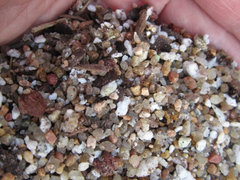
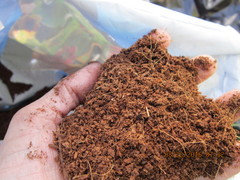
Edit: Oh, sorry, Carol, I cross posted. Re. your questions, I haven't been bottom watering cuttings while they root, but that's just me & my situation. Straw is doing great rooting & she IS. I will definitely try her suggestions, especially for the difficult to root (for me!) HTs.Since my losses are almost always due to rot, I don't generally even water the cuttings at all--the intermittent mist keeps the cuttings & media hydrated enough. I run it on a timer at 15 seconds per hour, more or less. Off at night & don't turn on until late morning during the hot season. I sometimes kick it up to 15 sec per 30 minutes if it's really hot & windy.
But I'm open to trying different methods. I'll try some with a richer media & bottom watering soon. Last fall I watered the cuttings still rooting in the sand with water with a teaspoon of gypsum dissolved in it about once per week as Straw suggested. We also have extremely alkaline water from a limestone aquifer. It makes sense that the calcium sulfate might help fight that. All those cuttings rooted very well--at a time of year I thought might be a bit too cool--mid Oct--Nov.
When I see roots, I upend the cups into my hand over a tub & gently pot them up into band pots (~3.5" square x 6" tall) with commercial potting soil. Watering them in gently, they seem to tolerate it well. They go near, but not under the mist, gradually moving them off to harden off. Then they stay in bottom watering trays until roots come well out of the bands. The band pots are virtually open at the bottom--just a couple of cross braces. From bands they go into gallons.
But you're right--the less they're messed with at such a sensitive stage the better. No matter how gentle, I'm still breaking off root hairs, etc. So it would be beneficial if I can get the hang of rooting in a growing media in a band pot with no intermediate sand stage.
strawchicago z5 thanked bluegirl_gwstrawchicago z5
Original Author7 years agolast modified: 7 years agoVaporvac: Thank you for sharing your good result with rooting, using "perlite/vermiculite/compost which is very light." One site stated that compost provides some magnesium, and my exceedingly high-magnesium clay helped speed up callous & rooting.
I did rooting-in-ground with clay/sand/gypsum and rooting in-ground with pine-fines-potting-soil/sand/gypsum and the CLAY BEAT PINE-FINES in earlier callous & forming roots. Why? Clay is high in magnesium, which helps in photosynthesis, esp. for rooting in partial shade. Wikipedia on magnesium:
"Excess potassium, generally due to fertilizers, further aggravates the stress from the magnesium deficiency,[2] as does aluminium toxicity.[3]Magnesium has an important role in photosynthesis because it forms the central atom of chlorophyll.[1] Therefore, without sufficient amounts of magnesium, plants begin to degrade the chlorophyll in the old leaves. This causes the main symptom of magnesium deficiency, chlorosis, or yellowing between leaf veins, which stay green, giving the leaves a marbled appearance."
Many thanks to Bluegirl who posted pics. of #3 coarse sand, that's what my neighbor-raised bed soil contains .. mostly coarse sand. Her 2 tomatoes are in full-sun, and she said they could not ripen no matter what !! So I gave her a big bag of red-tomatoes (planted in high magnesium clay). I was puzzled, since my tomatoes get less sun than her, but get ripe fast .. then I realize that magnesium is essential for photosynthesis ... she was using high-potassium fertilizer in a loamy & sand mix, that drove down magnesium, so her tomatoes could not ripen, not even in full-sun.
strawchicago z5
Original Author7 years agolast modified: 7 years agoJust saw Bluegirl's post .. THANK YOU for those fantastic pics. of the medium used. That's the 1st time I see chopped up co-coir, looks really good. I should soak mine coir-brick tonight so I can touch it to see if it's dry and crumbly like $$$ sphagnum moss.
The old-cafeteria trays are so handy: breakfast in bed, and college-kids used to steal that from dorm to use as toboggan for sliding down icy hill.
I like the crumbly texture of #3 sand, perlite, and chick-gravel .. sure beats dense peaty-potting soil !! The MG-moisture control potting soil (mostly peat-moss) was so dense that I had to use steel scoops to cut through, how can roots go through that ??
ANSWER TO CAROL'S QUESTIONS:
Should I put the cutting cups into bottom water now, or wait until I pot up with the different soil? I would wait, coir and sand holds plenty of moisture.
- Wouldn't it be better to leave the roots in contact with the soil they're in instead of tearing them out of the soil to put in new soil (does that make sense?) Yes, leave roots-in-tact with the soil, don't break them when moving.
- good to know about yellowing leaves means to change medium (more than 1/2 sphagnum moss and less than 1/2 perlite) and pot up a size.
The medium Burling used in 2012 with really dark green leaves had mostly chopped sphagum moss, next was potting soil, and some perlite. My guess for the ratio was 4:2:1. Spahgum moss is acidic, so it was perfect for Burling's alkaline CA tap water. Below is a pic. of greenish florist moss, sold for $6 per tiny bag:

bluegirl_gw
7 years agolast modified: 7 years agoHeck, maybe I should try dissolving a few Mg tablets in some water! I used to live where we had that same dense black gumbo clay--high in MgSO4. Our water there would leave black rings on the toilets & sinks, but I bet it was good for the plants, though on the balance the water was alkaline.
here we have very little real soil--only what we can develop with organics. And under any thin dusting of dirt is caliche--calcium carbonate. It's just easier to grow off roses in pots. But some that are well adapted like the teas, Chinas, et. al. will do okay in the ground. It's a big deal initially--pickax out a huge hole & fill with potting mix then mulch heavily--but the things we've taken the trouble to do right like that have done well.
Edit: dang, cross-posted again! Sorry! Also sorry for the incorrect information--I'll shut up now :-p
Thanks for your answers & patience, Straw :-D Yeah, coir is great stuff! It comes in those tight, heavy bricks, but after a hot water soak it just kind of comes apart. Then you can rub any clumps when the water cools to get them into the mealy texture. I got a bunch recently & went ahead & re-dried it in the sun afterward so I could sack it up to have on hand as needed, already fluffed into that nice texture.
Maybe you can scout around for a more reasonable price on sphagnum. IIRC, our local nursery has bales of it & while not cheap, I want to say it was like 20-25 bucks for a huge bale. It is the fibrous stuff--not sphagnum peat. I'll check back.
strawchicago z5 thanked bluegirl_gwrosecanadian
7 years agoWebsite says Calgary's pH is between 7.3 and 8.1. So that means it's alkaline, right? How's that for not understanding even basic, basic chemistry. So, if I'm right, I should use gypsum for my cuttings and for my roses in general??
So it sounds like I'm good for the first stage...then if it works,...I'll do what you guys say. Boy, I sure hope this works!!
I've really learned a lot!! Thanks everyone!!
Carol
strawchicago z5 thanked rosecanadianstrawchicago z5
Original Author7 years agolast modified: 7 years agoBuegirl: I don't see any incorrect info., and I like what you shared. I benefit lots from your experience, and love your honest sharing, THANK YOU. Cross-posting is fun, it's brainstorming at the same time for ideas.
Bluegirl, regarding your pic. of #3 sand & chicken grit & perlite. Years ago I checked on chicken grit and found the pH to be alkaline. Would mixing in acidic peatmoss (pH 4) help that mix to be moister & more acidic for hybrid teas?
Carol: Your roses are grafted on multiflora, that prefers acidic soil, thus gypsum at 17% sulfur is OK. Yes, rootings like it acidic like rain water (pH 5.6). There's one study by University Extension that cuttings root better when acidic peat-moss (pH 4) is used. I posted that years ago, will dig it up.
I went back to Khalid's thread "Rooting rose cuttings" & saw fantastic pics of his rootings .. so bushy & green, below is what Khalid wrote:
"Straw: The medium I used this time is 50% dry leaves and willow twigs and 50% soil. Then I covered the cuttings with a thick layer of dry leaves. Let's see how it works."
http://forums.gardenweb.com/discussions/3566166/rooting-rose-cuttings-methods-and-techniques?n=62
*** From Straw: Willow twigs has rooting hormone, I have 2 willow trees and will get the old stems to grind in a food-processor . Agree with Khalid that covering the cuttings with dry leaves help. I have 7 rooting pots now. The one under the cherry-tree is doing best, lots of leaves fell on top. I don't water that one, so it doesn't rot. The other ones looked dried out on top, so I was foolish to water it, and a few rootings rot IMMEDIATELY.
Bluegirl is right about cuttings don't have roots, so they don't need water. But the soil should be moist, thus a layer of leaves of top like Khalid locks in moisture. Plus decaying leaves give off acid, which helps with rooting.
strawchicago z5
Original Author7 years agolast modified: 7 years agoRe-post info. that I collected on type of soil and rooting. Cheryl Netter, who invented the "baggie method" for her cold zone 5a Colorado, used Peter's professional potting soil.
Peter's potting soil added bark ash (alkaline), which supplies calcium, potassium, magnesium, and all trace elements. Metro Mix also has bark ash, and is used in greenhouse veges seedlings. Granite sand is rich in potassium and phosphorus.
Peter's Professional Potting Soil Grace- Sierra
Canadian sphagnum peat moss, vermiculite, granite sand, bark ash.There's a 2 years study by Colorado State University on potting mixes by Carl Wilson, Extension Horticulturist. Here's an excerpt from the link below:
"Second, Hyponex All Purpose Potting Soil and Green Charm resulted in poor plant growth. Both of these media contain sedge peat, a fine particle material that tests to a low porosity. There simply isn't enough space within these media for the water and air that plant roots need to grow successfully. Black Gold All Organic Potting Mix resulted in significantly less plant growth in one out of two years.
Here is a link that might be useful: Cosumer Beware Potting Mixes Choices
*** From Straw: the Lowe's Sta-green potting soil that killed a few rootings that I got from Bluegirl last year? It has sedge peat, awful black stuff that water can't drain, so dense with zero oxygen for root growth.
Al Tapla's fast draining container-recipe is best for rooting roses in stage 2 (after callous) 4:1:1 (pine fines, peat moss, sand).
Gardenguides,com has detailed instructions on how to root:
Cut one or more stems (new growth), making the cut with a sharp blade just below a leaf node. Stems should be about 6 to 8 inches long and the cut should be made at a 45-degree angle. The best stem candidates for cuttings are tips of branches that have recently bloomed.
Remove the leaves on the lower half of the cut end of the cutting. Leave the leaves at the upper end.
Dip the cut end of the cutting into powdered growth hormone. Knock off excess growth powder.
Fill the pots with a mixture of approximately two-thirds sand and one-third peat moss, well mixed.
Make a hole in the potting mix using a pencil or similar object. Insert about half of the cutting into the soil. Tamp the soil around the cutting until it is firm. Water until damp.
Cover the pot with a plastic bag and secure around the pot to form a make-shift greenhouse. You can also use a washed plastic 2-liter soda bottle for this. If you choose this option, cut the bottom end off and place the spout end of the bottle over the cutting, creating a mini greenhouse with an open "chimney" at the top for air circulation.
Place the pot in a warm location where it gets 4 to 6 hours of indirect light each day.
Remove the soda bottle or plastic bag occasionally to prevent the constant dampness from causing the cuttings to rot. Make sure the soil stays damp, but not overly wet. Watch for new leaf growth, which should begin in 4 to 8 weeks (2 months). At the first sign of new leaf growth remove the soda bottle and allow the rose to have at least an hour or two of direct sunlight a day.
strawchicago z5
Original Author7 years agolast modified: 7 years agoRe-post info. from 2015: Here's a good link where Karl Bapst used Jilly peat-pellets, tried that, didn't work since I don't have a misting system:
http://forums2.gardenweb.com/discussions/1709578/help-rooting-then-rotting?n=10
karl_bapst_rosenut(5a, NW Indiana)
I use perlite and/or expanded Jiffy 7 peat pellets to start my cuttings. Neither require sterilizing.
The peat pellets nest in the perlite which holds them erect and provides a moist environment. Perlite drains well so the cuttings don't drown.
Misting nozzles on a timer set for 5 minutes every 2 hours keeps them amply moist.
For me, starting cuttings in peat pellets allows me to remove them from the perlite without damaging the tender new roots.oldroser(z5)
They are damping off. I spread milled sphagnum moss (not peat moss but finely ground sphagnum - the stuff used in hanging baskets) over the surface. it has an anti-fungus, anti-bacterial action. You can get it at your local garden center under the name of "No Damp Off." You don't need much, it is dust fine and very light. I also use it when starting seedings - great stuff" oldroser (z5).
*** From Straw: HomeDepot sells "No Damp Off" sphagnum moss at $4 per bag:
http://www.homedepot.com/p/222-cu-in-No-Damp-Off-Seed-Starter-0001/204372507
Some reviews of the above: " Based on the advice of a local gardening expert, I started adding a layer of this milled sphagnum moss on top of my the soil in my seed pots. Wow!!!! I haven't lost a seedling to damping off since. "
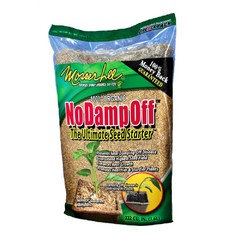
strawchicago z5
Original Author7 years agolast modified: 7 years agoRe-post info. I collected in 2015: There's an Australian soil-company that lists the percentage of soil sold for specific purpose. For rooting, they sell 5 part perlite to 1 part coco-coir. From Roses forum, 2006 thread:
http://forums.gardenweb.com/discussions/2136836/heard-this-on-tv-and-people-have-done-it?n=5
elks(US5 Can6)
Straight coir has worked best for me, with a greater number of fatter roots resulting. Steve. Here is a link that might be useful: My Method
http://www3.sympatico.ca/wm.saundersrose/articles/overwintering.html
An excerpt from Steve's method: "Where most agree is that cuttings should have four leaves with usually five or seven leaflets. The bottom two should come off. From there, I make a fresh cut under water, on a diagonal just below the bottom node, that is, where the bottom leaf just came off. I score up the cane from there about 1" (2.5 cm) on each side of the cane through the bark.
I have most success striking the cuttings in 6" pots filled with coir (ground coconut shells) and a little compost. Recently, I have learned that waterings of H2O2, hydrogen peroxide, {5 ml/ 95 ml of water} increases root development in olive cuttings. Dip the prepared cutting in a strong rooting hormone, such as Rhizopon AA#3 powder (0.8% IBA in talc). The powders work better than the liquid. Last summer, I started only 24 cuttings and lost one by the end of summer, but all remaining came through the winter unscathed! I have started HTs, floribundas, shrubs and OGRs; it does not seem to matter, so enjoy." Steve Elkerton.
strawchicago z5
Original Author7 years agolast modified: 7 years agoEffect of Peat Moss and Sand on Rooting Response of Cuttings
A. E. Hitchcock Botanical Gazette Vol. 86, No. 2 (Oct., 1928), pp. 121-148
http://www.jstor.org/stable/2470656?seq=1#page_scan_tab_contents
Abstract
1. According to their rooting response in peat moss and in sand, 96 varieties of cuttings (including 46 genera) have been classified into three groups. The fact that cuttings in all three groups rooted readily in a mixture composed of equal proportions of peat moss and sand indicates that this mixture is superior to sand as a general medium in which to root cuttings.
... more rapid rate of root growth occurred in a medium containing peat moss than in one containing only sand. Good rooting occurred for most varieties of cuttings over an acid range of pH 4.5-7.0."
*** From Straw: pH of peatmoss is 4, but sand is alkaline (over 7), thus bring the pH to between 4.5 to 7, which is ideal for rooting. Gardenguide's method of 2/3 sand and 1/4 peatmoss makes sense. Peatmoss is cheap at $10 for a large bale, but the particles is so fine, that it needs other COARSE particles to prevent compaction.
strawchicago z5
Original Author7 years agolast modified: 7 years agoHere's a great garden blog and documented what the experts say, see below link: http://www.growingthehomegarden.com/2009/05/sand-vs-soil-for-propagation.html
" Master Gardener Extension at Ohio State University stated:"A suitable rooting medium is half perlite and half sphagnum peat moss. Any disinfested container with drainage is acceptable."
North Carolina State University stated:"The rooting medium should be sterile, low in fertility, and well-drained to provide sufficient aeration. Materials commonly used are coarse sand, a mixture of one part peat moss and one part perlite, or one part peat moss and one part sand. Vermiculite by itself is not recommended, because it compacts and tends to hold too much moisture. "
*** From Straw: Agree, 2 people told me that vermiculite rotted their cuttings. I'm going to test 2/3 play sand and 1/3 acidic peatmoss for STAGE 1 (inducing callous via a tight & moist contact). Play sand holds more moisture than coarse sand, that way I don't rot the cuttings by frequent watering in STAGE 1 (first few weeks of callous).
rosecanadian
7 years agoWow! A wealth of information!!! I am so impressed. :)
Thanks so much for gleaning all this info Straw and Bluegirl.
Carol
bluegirl_gw
7 years agoYou're so very welcome--I'm enjoying all the great ideas, too. I need to print this thread out, LOL! Straw, thank you for looking up & typing up & sharing all that great info!
There are two types of distinctly different chick grits available. One is finely crushed oyster shell--provides Ca for them, but of course, it's very alkaline for horticultural use, though I have actually used it in mixes for things that love well drained alkaline soils before I moved here where that is what we have. Used to grow thymes & some cacti in it.
The other is finely crushed granite grit, which I'm using for cutting mixes. Most common brand down here is Gran-I-Grit. Available at Tractor Supply & many feed stores. I use the chick size--finer than that for mature birds. Rather like the texture of steel cut oats.

I used the milled sphagnum moss back when I used to start a lot of seeds--back when I lived on the humid coast with the black gumbo soil & 40" of rain--like your climate/soil during the warm season. It was great stuff. Very light weight, you could just sprinkle a bit on top of seed flats & it helped reduce dampning off. Had a mealy texture with none of the fibers associated with the long strands of florist type sphagnum. Not cheap, but you don't need a lot to just cover the top of the media.
I also used to do a weekly watering with about 10% mixture of regular peroxide & water. It's supposed to be a very mild disinfectant & even beneficial for cuttings & seed flats. Supposedly it reduces algae & fungal growth. Perhaps I'll try that again.
Annnnd, since you mentioned it (I didn't know whether it would offend the purely organic growers here) I DO use a commercial hormone--Rhizopon #3, which is the strongest, at .8% IBA. Far stronger than what's commonly sold at garden supply stores. It's not cheap, about $45 for a quart, but that lasts for years if stored cool & dry. It made a huge difference in rooting rose cuttings. Until I started with that I never could root the things, so I still use it. I used to split an order with the nearest rose-rooting pal.
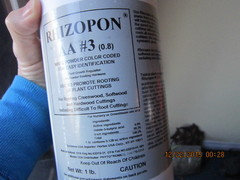
A lot of folks like Dip-N-Grow. I've used it a bit but find the Rhizopon more convenient. Dip N Grow is a liquid concentrate that you mix fresh into a solution cup to stick each batch of cuttings. IIRC, 1:12 strength seems to be most popular for roses, though the package says 1:15.
And for those who like the convenience of pellets, Jiffy is now making coir pellets. Last time I checked, they also make a big pellet that expands to ~2" high, so that might be a convenient way to stick cuttings, too. You mentioned you got some rooted using 2 of the smaller pellets stacked on top of each other in a pot with a hole punched through. Another advantage of those is preventing transplant shock since you can just drop the pellet with the rooted cutting into potting soil directly.
The pellets & rockwool cubes can just sit in shallow trays to root.
Lots of neat ideas here! I can't wait to start up a bunch of cuttings this fall :-D
strawchicago z5 thanked bluegirl_gwstrawchicago z5
Original Author7 years agolast modified: 7 years agoBluegirl: Thank you so much for the pic of Indole-3-butyric acid 0.8% and Granite grit. The texture of Granite grit reminds me of the potting soil from Roses Unlimited: dry fluffy pine fines, some potting soil, some vermiculite & perlite.
Thanks for the info. of BIG Jiffy-pellets .. those are very dry .. best in the "baggie method". Plus they are sturdy & can be re-used. I threw some into my compost pile and it took forever for those pellets to break down, zero mold on them. Great suggestion on those pellets sitting in a tray of water !!
But other soils with peat moss & organic fertilizer retained too much moisture, lots of gnats & nasty mold after my kid was done with her science experiment.
strawchicago z5
Original Author7 years agolast modified: 7 years agoRhizopon #3 is awesome !! Thank you, Bluegirl for sending me that. Cuttings retain leaves longer when I use that, versus dropping leaves, then growing new ones.
I bump up this thread to see Khalid's info. before I order roses for next spring. OWN-ROOT William Morris absolutely HATED acidic & peaty potting soil, and hates my heavy clay (made slightly acidic). That one likes loamy & fluffy & alkaline. Saw the Dark Lady doing very well at Chicago Botanical (loamy alkaline soil), the Dark Lady has Rugosa heritage, thus drought-tolerant. Golden Celebration is a biggest water-hog as own-root. I grew Paul Neyron as own-root before, it was a BS-fest in clay made acidic with alfalfa, and did best in loamy & neutral to slightly alkaline potting soil.
Khalid: Are these roses own-roots, or grafted on Centifolia in your hot & monsoon climate? Re-post Khalid's best roses, here's what he wrote:
CATEGORY A - CULTIVARS THAT PERFORMED REASONABLY WELL IN HOT SUMMERS AND MONSOON
Crown Princess Margareta, William Morris, Glamis Castle, The McCartney Rose, Paul Neyron, Rose de Rescht, The Dark Lady, St. Swithun, Alan Titchmarsh, Graham Thomas, Golden Celebration, Iceberg, Burgundy Iceberg, Casino, Ebb Tide, St Ethelburga, Westerland, Blue for You." KhalidKhalid Waleed (zone 9b Isb)
7 years agoStraw wrote:
Khalid: Are these roses own-roots, or grafted on Centifolia in your hot & monsoon climate? Re-post Khalid's best roses, here's what he wrote:
CATEGORY A - CULTIVARS THAT PERFORMED REASONABLY WELL IN HOT SUMMERS AND MONSOON
Crown Princess Margareta, William Morris, Glamis Castle, The McCartney Rose, Paul Neyron, Rose de Rescht, The Dark Lady, St. Swithun, Alan Titchmarsh, Graham Thomas, Golden Celebration, Iceberg, Burgundy Iceberg, Casino, Ebb Tide, St Ethelburga, Westerland, Blue for You." KhalidStraw: As following....
Crown Princess Margareta (Centifolia), William Morris (multiflora and own root, own root performed better) , Glamis Castle (Centifolia), The McCartney Rose (Centifolia), Paul Neyron (Centifolia), Rose de Rescht (Centifolia), The Dark Lady (Centifolia), St. Swithun (Centifolia), Alan Titchmarsh (Centifolia), Graham Thomas (Centifolia), Golden Celebration (centifolia and own root, both root performed well), Iceberg (Centifolia), Burgundy Iceberg (Centifolia), Casino (Centifolia), Ebb Tide (Centifolia), St Ethelburga (Centifolia), Westerland (Own Root) , Blue for You (Centifolia).
Hope it helps.
strawchicago z5 thanked Khalid Waleed (zone 9b Isb)strawchicago z5
Original Author7 years agolast modified: 7 years agoKhalid: Thank you for that list of what's on own-root vs. grafted. Heirloom roses listed Casino and Westerland for partial-shade section. I notice that light-yellow, orange and dark-red roses take partial shade well.
Just found that Master-Garden soil mix for tree & shrub with acidic pH sold at Menards is actually 100% peat moss, rather than pine-fines as FALSELY WRITTEN on their bag.
I did an extensive search that found they replace $$$ pine fines with cheap peatmoss. I got suspicious when I used it: all peat-moss, didn't see any pine-fines. That rotted 90% of my cuttings, even when I mixed in more than 1/2 coarse sand.
Same with Miracle-Gro for seedlings: 100% peatmoss that killed my rose-seeds: it's soaking wet on top, and dry at the bottom !!
Same with Miracle-Gro for orchids: 99% peatmoss and 1% pine-bark (just to mislead orchid growers. I read the reviews on Amazon and orchid-growers got mad since it rotted their orchids. They recommend Better Gro-orchid mix with ACTUAL fir bark. If you click on the link, it shows chunky bark-chips, very much like what Roses Unlimited uses for their own-roots. Better Gro-orchid mix is sold at Lowe's and HomeDepot, that helps with better drainage for cuttings and own-roots that like loamy soil. Will use that for my cuttings next year:
http://www.homedepot.com/p/Better-Gro-8-Qt-Special-Orchid-Mix-50020/100127480
Better-Gro 8 Qt. Special Orchid Mix for $5.97 at HomeDepot
Organic; contains fir bark, hardwood charcoal and coarse perlite
- Endorsed by the American Orchid Society
strawchicago z5
Original Author7 years agolast modified: 7 years agoVery happy to find "Ace Hardware pine bark mulch", which are well-composted this Oct, and have plenty of pine-fines inside. I make my rooting-area in advance for next spring .. by that time the pine-mulch/pine-fines will be more decomposed & less acidic.
The rooting powder that Bluegirl mentioned helped TREMENDOUSLY. Things take roots much faster.
Do you make a slit at the side of the lower cane like Connie of Hartwood? Or do you slice a piece of outer-layer off like Kitty of California? I'm too lazy, so I do it California way, scrape a vertical piece off from the end, with my paring knife.
For indoor & winter: I still don't like covering the plant with a plastic dome, it goes against my logic: cover anything up, and it will surely rot & get moldy !! My kid sprouted some mung-bean in a plastic cup, she covered it, and within a few days white mold grew on it, so gross !!
This winter I plan NOT to cover with plastic, and simply squirt the soil lightly with a hand-mister. My neighbor kept a geranium through the entire winter. In freezing March I visited her: she kept the geranium on the window-sill (morning sun), and squirt it twice a day. And it was blooming tons !!
I kept house-plants indoor in the winter and was foolish to water it, that was messy: water dripped on carpet, then whiteflies, then rotted stem (too wet). Hand-mist lightly is so much better, since leaves do take up water & nutrients .. same with stem
I also put hydrogen peroxide inside my hand-mister to prevent rot. Bluegirl shared how Josh in TX put a paper towel on top of the rooting area to hold in moisture, great idea !!
I'm convinced that hard-wood and thick cuttings NEEDS MUCH LESS MOISTURE. Versus the "greener & thinner" stems which dry out faster, thus need more moisture.
The "alfalfa sprouts" type of root need constant moisture ... folks do keep alfalfa sprouts in a plastic pouch at grocery store. But the woody & chunky Dr.Huey-rootstock rots easily in poor-drainage clay. As own-root matures from "alfalfa sprouts" to hard and woody roots, they become more sensitive to standing-water and acidity.
rosecanadian
7 years agoI'm trying to get some cuttings to grow roots and overwinter too. I've been misting. They're still alive...don't really know if they're growing roots or not.
Carol
strawchicago z5 thanked rosecanadianstrawchicago z5
Original Author7 years agoCarol: Last night I check on when to remove the pop-bottle, one site said after 2 months (with plenty of new leaves), remove the cap. Then after 3 months, remove the entire bottle.
Khalid showed how rooting with hard-wood cuttings in late fall produce a plant MUCH FASTER than soft-wood. Below is an excellent link of where to cut for hard-wood (one 1-year old stem that branches off from 2 year-old trunk):
https://deepgreenpermaculture.com/diy-instructions/propagating-hardwood-cuttings/
The above link said to use 1/2 peat with 1/2 sand, or 1/2 peat with 1/2 perlite. Hardwood cutting has a THICKER outer layer, thus ACID is needed to help roots break though, so the 1/2 peatmoss will provide the acidity to counter-act the alkalinity of sand. Sand is still alkaline even if there's tons of rain .. I'm re-using my sand (went through many heavy rains), and my rootings still sprout pale leaves !!Next year I'll use 1/2 peatmoss and 1/2 sand, that will make more acidic to root hard-wood cuttings better.
Vaporvac Z6-OhioRiverValley
7 years agoWhat fantastic articles. I love rooting things. This year I did the usual tiny tradescant, jasmine, dracaena and some roses. I'm trying over the winter hydrangeas and a hardy laurel. After reading this post, I'm going to attempt a hardwood cutting from my super fragrant philadelphus and the cornus mas that I usually grow from seed. Out of three mock oranges only one is fragrant, but the flowers on the other to are so pretty. We'll see how it goes. I just need to get more perlite and some peat.
strawchicago z5 thanked Vaporvac Z6-OhioRiverValleyrosecanadian
7 years agoWow! That's really useful!! It also means I can go take some cuttings from my roses in the garage. I'm going to wait until I can get some cactus soil.
Carol
strawchicago z5 thanked rosecanadian
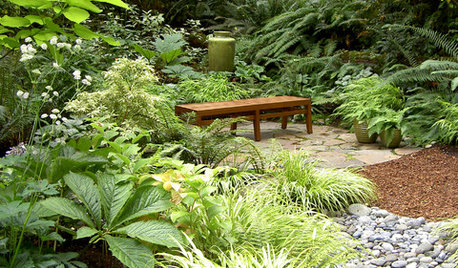

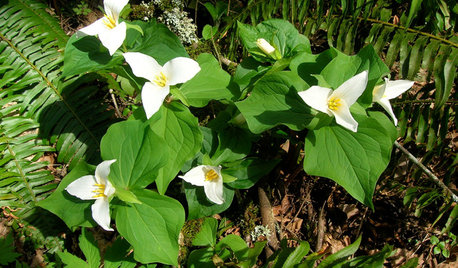

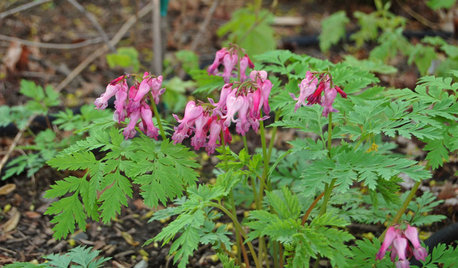
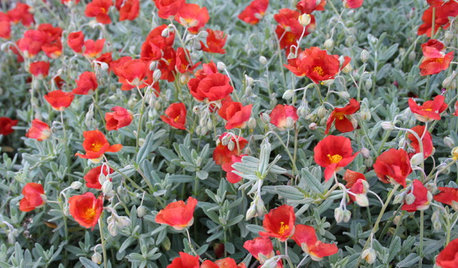

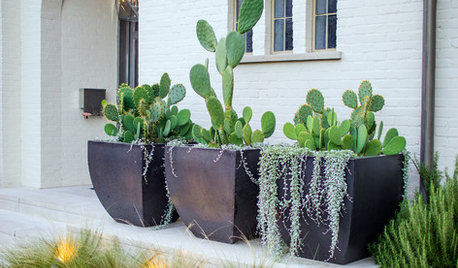

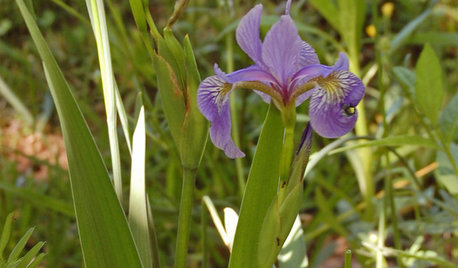





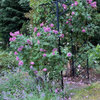

bluegirl_gw